Stop me if you’ve heard this one, or one like it.
The story starts in a remote, boring little bucolic space where nothing is happening but there’s talk about an old mystery that connects to a family line. Our hero, Tenchi Masaki, wants to go explore the interesting thing, but his grandfather tells him he has to do his chores, instead. When he slips from his grandfather’s attention, he winds up exploring an old cave he’s been told not to, whereupon he gets a sweet laser sword that’s a relic from a more civilised age, and also wakes up an ancient demon, which kicks off a series of events resulting in his whole house being teleported next to the same bucolic shrine, meaning it’s easy to hide spaceships coming and going, and you don’t have to draw as many backgrounds in a city or non-major characters.
Along the way, he discovers the demon is actually a cool space pirate who wants to jump him, she’s being hunted by a haughty princess, who wants to jump him, and then a steadily coagulating core of Other Girls arrive to join in the queue of Wants To Jump Him.
It’s not a hentai.
There’s spacefaring adventurers, battles with galactic criminal types, a vast interstellar empire, and deep powerful forces that well up from inside Tenchi (who is secretly a prince).
Now I may have described The Most Generic Anime Plot ever, but the good news is that’s because I also described The Most Generic Anime ever, an anime that has been part of the background of anime for a while now.
Content Warning: Mentions of incest.
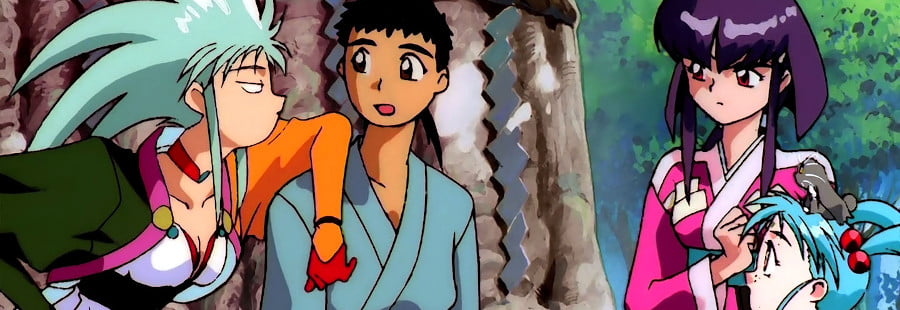
Tenchi Muyo! started as a thing called an OVA, or an original video animation [citation needed]. These were cheap-to-purchase short, often story-abridged animations designed to stay by the entrance of stores in Japan to encourage impulse purchases. Ostensibly, OVAs were something animation studios did to get the attention of larger producers to finance series, to prove there was a market for something they were doing, to test markets, and sometimes as a sort of piece of merchandise, like a particularly nice statue for something that was already popular.
OVAs were meant to be visually engaging, easy to advertise, and typically, very approachable. Some OVA series were maybe four episodes long, spread across two purchases, and you usually got what amounted to a kind of anime movie, bit longer, maybe a bit shorter. Successful series often got an OVA that was a sort of out-of-continuity side story. Ranma 1/2 used OVAs to cover stories that the TV anime never got around (and a wholly new one), for example.
That kind of plays into how Tenchi Muyo! starts out.
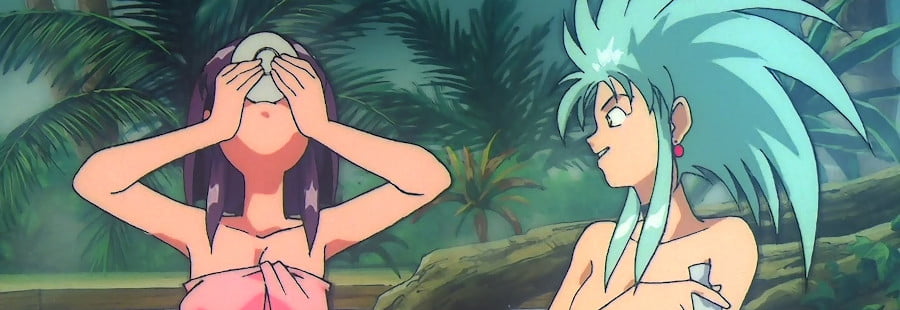
An aside, though, before we get going. It’s important to remember, when we talk about anime culture, that those are English Words, written in English characters. Whenever I want to talk about ‘anime culture’ as a whole, remember that there was a time when that was something that was experienced in a very different way, with a contact surface that was always a limited window of a limited window. There were fansubs of obscure things, there were VHS tapes of the ‘name’ things, and there were always limitations on what was treated as ‘worth’ attention in the space. Bear that in mind when I talk about ‘important’ anime, it’s always as an outside observer, being limited in his perception by what was being sold to people like me.
It’s a happy coincidence that I was a white boy from an English-speaking country, of course – I was the target audience for most of it.
Nonetheless, understand those boundaries when I say an anime was ‘important’ or part of the ‘media landscape.’ It was part of mine, and part of the landscape of a lot of people I know, even people I never met at the time, thanks to distribution and desperation. It was not, and should not be seen as, expertise about what anime culture was like in the country it was coming from.
(And this holds true for today – we have a lot of anime commentators who are delightfully innocent about just how much work their own framework as queer millenials does making media from Japan into ‘good queer content.’)
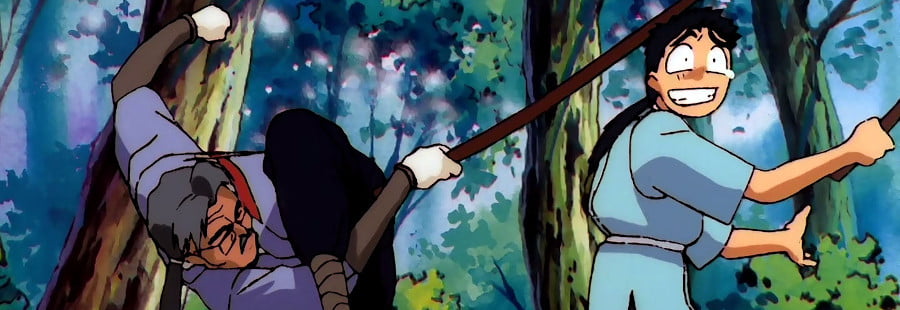
I’ve said in the past that Ranma 1/2 was the ‘first’ Harem Anime. If I was going to point on a timeline of what we, in the west, see as ‘the harem anime’ of the time, the next step would definitely be Tenchi Muyo! It isn’t that Ranma 1/2 invented the trope (though it kinda did), but it was one of the most successful series doing it. Tenchi Muyo! was the first high-production anime released into the market after Ranma 1/2 presented the formula.
Where Ranma 1/2 grew into the harem anime slowly – it wasn’t until five full months of Ranma 1/2 weekly releases to introduce the three core components of the Waifu Collection, Tenchi Muyo! was a little more aggressive – you had the core collection of girls in the same house in the first three episodes. One must almost marvel about the efficiency at least.
And incidentally, if you want to know about that ‘next’ tentpole harem anime in the west, it’s probably Love Hina.
There was a time in the 90s, where with the erratic release and translation schedules of these things, with three TV series happening at more or less the same time, that just by volume, any given anime explorers’ space was going to hit some Tenchi Muyo! stuff. I didn’t seek it out, but thanks to it – and its wild difference to Ranma 1/2, I honestly kind of assumed that ‘oh, harems are just a thing in anime.’
Because here’s the thing: Despite that outline of how OVA media worked, Tenchi Muyo! wasn’t ‘just’ an OVA, a scrappy little series that wanted to will itself into existence through fan popularity.’ No no.
Tenchi Muyo! isn’t a series.
Tenchi Muyo! is an empire.
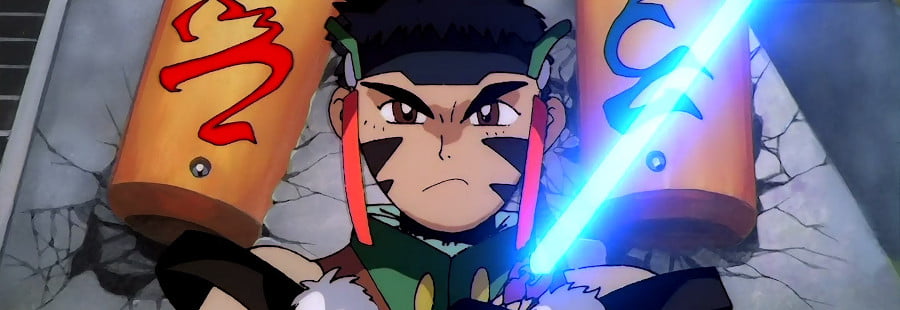
The full list of Tenchi Muyo! media is one of those things that looks like a Gantt chart of a project from hell. There have been four Tenchi TV series, three feature films, five spin-off series including three spinoff series of those spinoff series, two manga series, at least one series of novels, a radio drama, a stage play, an entire connected series (called Photon: The Idiot Adventures, which is, not good but whose opening theme fucking slaps), and if you want you can St Elsewhere this whole connected mishmash of media into one single narrative continuity that doesn’t fucking matter.
Oh, and that first OVA series? The thing where it started, with the promise that ‘hey, if you pick this up, we’ll be able to finish the whole series?’ It was four OVAs long, with the first released in 1992, and the last released in 2017.
Is Tenchi Muyo! such an enormous sprawl of media because it’s fantastically popular? I can’t really say it is, because Tenchi Muyo! has always had the feeling of someone’s third favourite series. Aside from one friend who, really, was just very into one character, the series has always been there as one of the anime spacefillers in western continuity. I don’t see people nowadays with throwback avatars to that. If I make niche jokes about it, I don’t hear people pipe up and go ‘oh man.’
None of this is to dismiss you if Tenchi Muyo! is your favourite thing. I know someone was trying to make it your favourite thing, so that’s a very reasonable reaction. See, it’s not just that Tenchi Muyo isn’t really a series. It’s a franchise, and nakedly so. That’s what it always wanted to be.
Tenchi Muyo! was not just created to make for another Tenchi Muyo! series, the way OVA series typically were. Tenchi Muyo! was an anime created to be an infinitely recycleable, constantly ongoing brand. From the top down, the purpose of Tenchi Muyo! was to be an anime franchise that could be in constant production, and it’s succeeded. Tenchi Muyo! has been in constant production, adjusting and updating to hot new trends. There’s a reason one of the series was a magical girl spinoff for tweens, and another was an urban social drama about moving away from home and going to college.
Next year, the first Tenchi Muyo! OVA turns thirty and during that entire time I am hard pressed to tell you a single example of what this series is about except ‘making sure there’s more Tenchi Muyo!.’
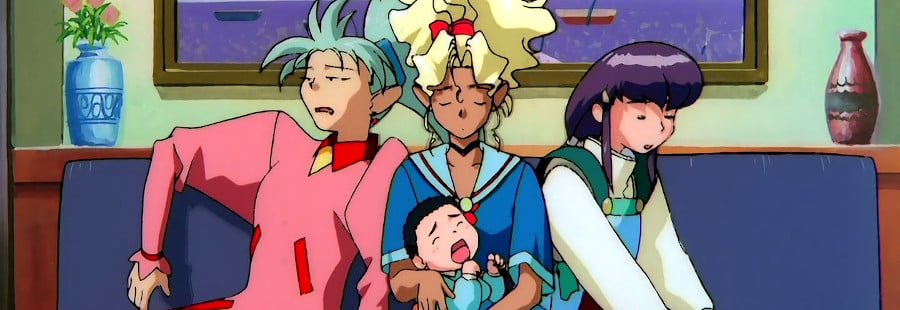
It’s important to recognise, though, that it’s not like Tenchi Muyo! is pulling some sort of magic trick to manage its incredible longevity. The franchise lives, basically, on being what it is – a low-enagement harem anime with laser swords (sometimes), and a bunch of characters you can have a general attachment to, but which are unlikely to present too many awkward parts of the narrative to drive you away from it.
That is to say, uh, this is a OVA series about Waifus, and the Fanservice they bring.
The thing with these waifus is that the characterisation tends to stay pretty consistent across the different forms of Tenchi Muyo!, more or less. I haven’t watched all of Tenchi Muyo!, because… how could I. Thanks to being largely archetypal, though, the characters of Tenchi Muyo! get to follow a standard characterisation, even if the events they go through are wildly different, across numerous narrative spaces.
A special note before I go on, though. You remember that whole ‘dub vs sub’ argument that has been going on in western anime conversations? Well, if you ever want to convince someone that dubs are an inherent bad, you should show them the original Tenchi Muyo! OVA dub. Character tone and voice vary wildly, deliveries are dreadfully awkward, the script repeats words in ways that indicate a weak translation from Japanese into non-naturalistic English, dialogue is in many cases rushed, and the character archetypes projected by the voice talents are wildly different. Ryoko seems to be aiming at feline and teasing, and Ayeka probably got told ‘princess,’ but the overall affect of both characters is extremely poorly directed. Ayeka doesn’t have any kind of natural ramp for her high-strung behaviour, so the voice actress just leaps straight to bLARHG really hard and fast, while Ryoko sounds like someone trying to be sultry who has heard of sexiness. I don’t doubt all these voice talents could do a good job, but in this OVA, they did not.
I can’t say for certain, of course, because it’s not available to stream here in Australia.
Ahem.
There’s also some just generic Anime Bullshit. Both Tenchi’s dad and grandfather are just awful about women and their boundaries, and it’s uncommented on, so there’s that. It does turn a lot of space battles into Wave Motion Cannon fests, and you see a lot of cleavage and boob-adjacent-ness even if you don’t see it see it. Where Ranma 1/2 was a comedy sex farce, Tenchi Muyo! wants that marketing without necessarily committing to doing anything like, sexy. Helpless women and sleeping women are kind of projected as a common ‘oo hot’ shot, which
Ereugh.
Anyway, let’s look at this lineup of Waifus.
First up, there’s Ryoko, a dashing rogue, which is to say, a homocidal asshole who almost kills Tenchi when she first meets him, and only stops because he gets lucky and cuts her hand off. There’s a lot of her character in this opening that’s kinda compressed. You know, going back to it I thought maybe I’d see a narrative that made more sense about how quickly she jumped from threatening to kill him to trying to ride his jock, but uh, nope.
Next up there’s Ayeka, who
Who uh
She’s Tenchi’s aunt?
Like, lots of generations removed, but she is absolutely related to him, because he’s the descendant of her half-brother, who she also wanted to bone. The OVA even does a little compressed ‘oh I know that must be weird to you but it’s totally normal to us,’ bit where Tenchi responds with ‘well, okay.’ And what makes it even more weird is that like, if it was just a happenstance of ‘multiple generations divide us,’ and a technicality, it’d be easy to forget? But Ayeka brings it up and sees his comparison to her brother as a plus.
Then there’s Sasami, who I’m told, is not off the waifu list, despite looking like she’s nine, because she’s actually hundreds of years old, and I Do Not Have Time To Unpack This Bullshit (Gilbert, 2019), so she is off the Waifu list.
There’s Mihoshi, who is a cop who’s clueless, irresponsible, causes harm everywhere she goes and views accountability as a problem, so she’s a cop.
There’s Kiyone, who doesn’t appear in this OVA, and is also, a cop.
There’s Washuu, who I guess deserves special mention alongside the Sasami in the field of Actually 20,000 years old, but I will at least give her this: She behaves like she’s an adult, and when she goes out of her way to get sexualised, from what I can find, it’s as an adult. She prefers to act like an inappropriate grandma most of the time, even if she’s uh
Kinda inclined to hint about sperm samples from Tenchi.
You know what, maybe this Waifu section was a mistake.
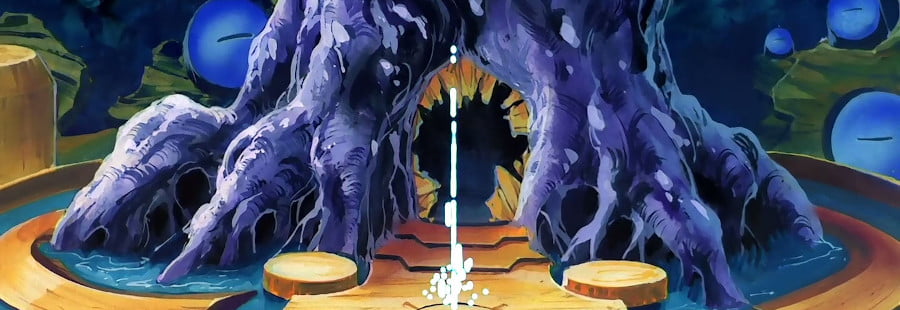
When we talk about anime in a reductive way, there’s always one question that comes up: is it good?
Setting aside how useless that question is, I think the better question for me is do I miss it?
I mean, there are some things in Tenchi Muyo that I think of as pretty cool. Like, laser swords are cool. There’s also the idea of the Juraian empire, where all their spaceships are big trees capable of floating around in space, meaning all the computers and systems aren’t represented by smooth techy panels and the like, but are instead shown as looking like organic things, floating logs as ‘robots’ and shards of natural wood as a kind of forcefield. That’s cool!
That plays through to the aesthetic, too. There’s sequences of these heroic characters, the noble lords of Jurai and their empire as being adorned in flower crowns, and using different flowers to signify different characters. I like that.
Yeah, uh, which means we have laser swords and wood computers. Those are cool.
Uhm.
I guess it’s hard to think too fondly of anything like this, though because when you know a story is explicitly not trying to go anywhere, and instead seeks to be always going, you’re left with a sort of cowardice about having opinions. It plays through in the way the characters are depicted, too – like, while the characters of 1992 are kinda creepy and weird, the recent iterations on them smooth that creepiness away. On the one hand, yay, losing creepiness, on the other hand, boo losing what little distinctiveness this gang of cypher waifus have.
(Cyphus? Saifu? Cyfu?)
It’s just so cynical, looking back on how this series started, knowing what it is and what it wanted to become.
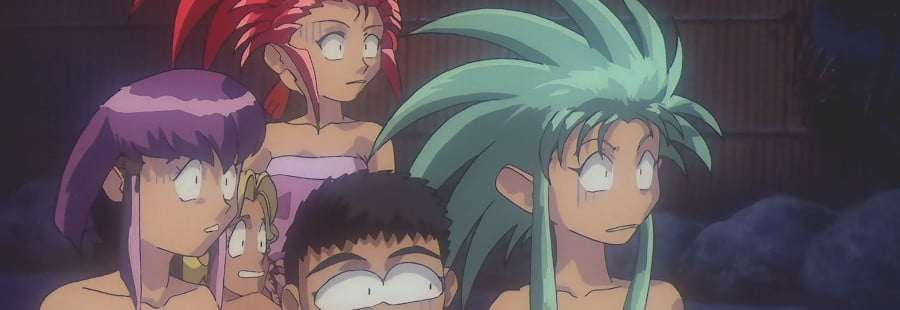
Why are we doing this, why, today? Because today is the Third of May, the day before Americans, with their ‘everyone reads the calendar the way we do’ manner of looking at the world, say it’s ‘Star Wars Day,’ because it’s May the Fourth (be with you). And knowing that, I could think of nowhere more appropriate to talk about this. There’s no place more appropriate, no time more appropriate, to bring up, and talk about the Anime that really, wanted to be pretty much just like Star Wars.
And that’s not me, that’s not me just pulling that comparison out of nowhere. As long as there’s been Tenchi media, there’s been forum threads, somewhere, whether on Usenet or not, about whether or not Tenchi Muyo, a series about a young man whose bucolic life he hates is interrupted by discovering he’s actually a long lost prince with mystic powers and a laser sword and incest, is a ripoff of Star Wars. Typically, the rejoinder is ‘well, isn’t everything, if you view it that reductively?’ and they’re kind of right if you ignore the incest and the laser sword.
When you dig into the currently known sources for Tenchi Muyo!‘s origin, you weirdly find that it started out as an idea for omake episodes of Bubblegum Crisis – where these two dudes had the idea ‘what if this anime about girls kicking ass, was instead, about this one dude and their days all orient around him.’ They also liked to compare Tenchi Muyo to ‘I Dream Of Jeannie.’
What do you get, when you miss the point of a story about women doing cool things, and want to make a marketable literal wish fullfillment narrative you can endlessly remake for money?
Well, you get a soulless, money-generating branding exercise that you’ll shovel money into until it or you dies.
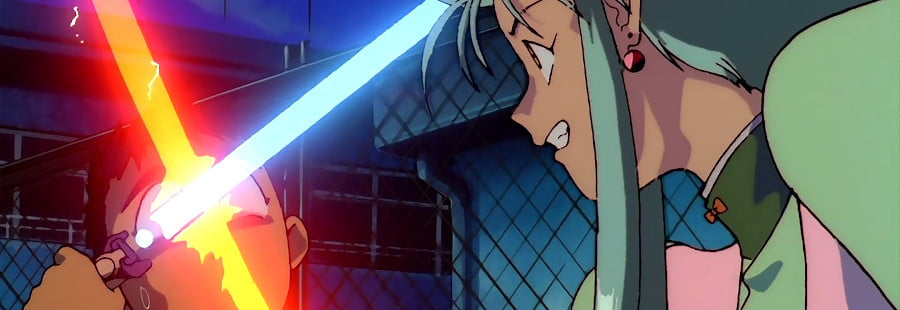
1 Trackback